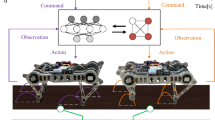Abstract
This paper presents the Finite element analysis (FEA), Multi-body dynamics (MBD) simulation and gait pattern analysis of a bio-inspired quadruped robot. A novel power transmission mechanism with varying gear train centre distance has been designed for generating different gait structures to suit unstructured terrain. The adjustable length of the lower link aids in improving the stability of the robot (or) make the robot to travel longer distances within a stipulated time. MBD simulation has been performed using MSC/ADAMS for torque, speed, energy and force analysis. The novel mechanism designed was able to successfully negotiate unstructured obstacles of different heights and these results have been presented in the paper. The results show a direct relationship between stroke length, lift-off distance and gear centre distance. A full scale experimental setup, along with the suitable supporting mechanisms is developed. The experimental analysis has been carried out for measuring the Ground Reaction Force (GRF). The GRF is found to be 45 N on an average, when the robot is walking.














Similar content being viewed by others
References
Wettergreen D, Thorpe C, Whittaker R (1993) Exploring Mount Erebus by walking robot. Robot Auton Syst 11:171–185
de Santos PG, Garcia E, Estremera J (2006) Quadrupedal locomotion: an introduction to the control of four legged robot. Springer-Verlag London Limited, London
Wadden T, Benjelloun K, Hardarson F, Wikander J, Ekeberg Ö (1998) Biologically inspired design of a leg for dynamic walking. Proc Euromech 375:228–235
Rawlings AE, Bramble PJ, Staniland SS (2012) Innovation through imitation, biomimetic, bioinspired and biokleptic research. Soft Matter 8(25):6675–6679
Alexander RM (1984) the gaits of bipedal and quadrupedal animals. Int J Robot Res 3(2):49–59
Bares JE, Whittaker WL (1993) Configuration of autonomous walkers for extreme terrain. Int J Robot Res 12(6):535–559
Gardner JF (1991) Characteristics and approximations of optimal force distributions in walking machines on rough terrain. Proc Int Conf Adv Robot 1:613–618
Vishal D, Manivannan PV (2015) Design and analysis of active vibration and stability control of a bio-inspired quadruped robot. Int J Comput Vis Robot. Inderscience Publishers
McGhee RB, Frank AA (1968) On the stability properties of quadruped creeping gaits. J. Math Biosci 3:331–351
Messuri DA, Klein CA (1985) Automatic body regulation for maintaining stability of legged vehicle during rough terrain locomotion. IEEE J Robot Autom RA-1(3):132–141
Vukobratovic M, Stepanenko J (1972) On the stability of anthropomorphic systems. J Math Biosci 15:1–37
Shih CL, Li YZ, Chung S, Lee TT, Gruver WA (1990) Trajectory synthesis and physical admissibility for a biped robot during the single support phase. Proc IEEE Int Conf Robot Autom 3:1646–1652
Yamaguchi J, Takanishi A, Kato I (1995) Experimental development of a foot mechanism with shock absorbing material for acquisition of landing surface position information and stabilization of dynamic biped walking. Proc IEEE Int Conf Robot Autom 3:2892–2899
Ito S, Kawasaki H (2000) A standing posture control based on ground reaction forces. Proc IEEE/RSJ Int Conf Intell Robots Syst 2:1340–1345
Goswami A (1999) Postural stability of biped robots and the foot-rotation indicator (FRI) point. Int J Robot Res 18(6):523–533
Sakakibara Y, Kan K, Hosoda Y, Hattori M, Fujie M (1990) Foot trajectory for a quadruped walking machine. In: IEEE International Workshop on Intelligent Robots and Systems, Ibaraki, Japan
Fukuoka Y, Kimura H (2009) Dynamic locomotion of a biomorphic quadruped ‘Tekken’robot using various gaits: walk, trot, free-gait and bound. Appl Bion Biomech 6(1):63–71
http://News.mit.edu/2013/mit-cheetah-robot. Accessed 20 Aug 2015
Author information
Authors and Affiliations
Corresponding author
About this article
Cite this article
Vishal, D., Manivannan, P.V. Multi-body dynamics simulation and gait pattern analysis of a bio-inspired quadruped robot for unstructured terrains using adaptive stroke length. Artif Life Robotics 21, 493–499 (2016). https://doi.org/10.1007/s10015-016-0304-7
Received:
Accepted:
Published:
Issue Date:
DOI: https://doi.org/10.1007/s10015-016-0304-7




